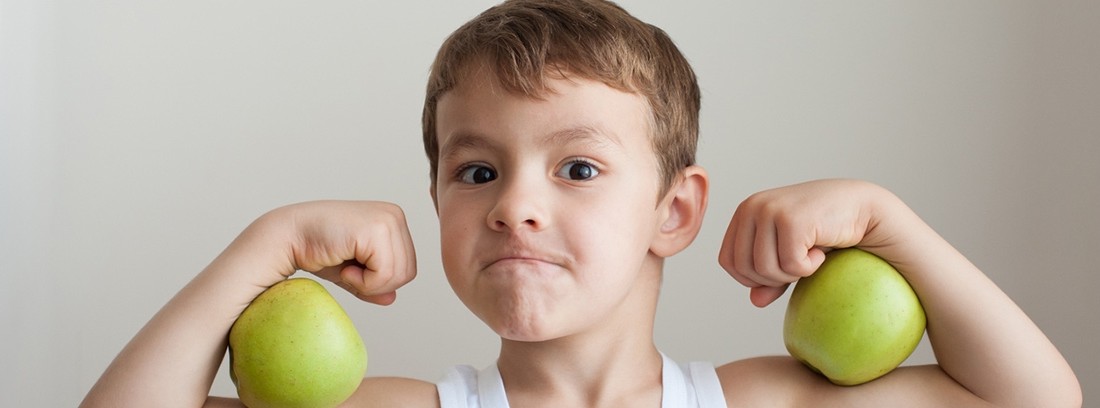Nutrients, minerals and vitamins

Carbohydrates
They must contribute between 45-60% of the total calories in the diet. Only 10% of the total carbohydrates must be simple sugars (white sugar, honey). 90% of carbohydrates must be slowly absorbed and high in fiber: cereals, vegetables and fruits.
Protein
They should be between 10 and 30% of the total calories in the diet, and should be half of plant origin and half of animal origin. The amount of meat that a child should eat from the age of 6 is 10 grams per year per day. Fish should be part of the diet two or three days a week.
Fats
They contribute between 25-35% of daily calories. They must be of plant and animal origin. Virgin olive oil, blue fish and nuts should not be missing. They are an important and reserve source of energy. They give the child an important feeling of satiety.
Fats of vegetable origin are important since, if they are present in the diet, we ensure a contribution of essential fatty acids (linolenic or linoleic acid, EPA, DHA) which are very important for the neurological and visual development of the child and for the regulation of cholesterol . These essential fats cannot be manufactured by the body, so it is essential that they are included in the diet. On the other hand, they are important for absorbing some vitamins.
Fiber
The child's diet must be rich in fiber to promote a correct bowel rhythm. The presence of fruits and vegetables in all meals (5 servings a day) and legumes is of the utmost importance.
Vitamins
Water-soluble vitamins: they need the body to ingest them daily because they are not stored in the body.
- B1 or Thiamine: helps metabolize carbohydrates. Sources: eggs, fish, cereals, legumes and liver
- B2 or Riboflavin: necessary in the metabolism of proteins. Sources: meats
- niacin: helps glucose metabolism
- B6 or Pyridoxine: helps the proper development and function of the nervous system. Sources: meat, seeds and grains.
- Pantothenic Acid: helps make hemoglobin. Sources: legumes, grains and liver.
- Biotin: important in the metabolism of fatty acids. Sources: corn, soy, egg yolk and cereals.
- Folate: important in cell growth. Sources: green leafy vegetables, legumes and liver.
- B12 or Cobalamin: Collaborates in the formation of red blood cells. Source: meat, eggs and milk.
- Vitamin C: it is a powerful antioxidant. Helps build bones, teeth, and collagen. Firms the capillary walls. It is necessary to absorb iron from the diet. Sources: fruit, green vegetables, broccoli, tomato, potato.
Fat-soluble vitamins
- Vitamin A or Retinol: it is important for night vision, to maintain the integrity of the skin and mucous membranes, for the growth of bones and has antioxidant action. Sources: products of animal origin.
- Vitamin D or Cholecalciferol: it is manufactured by the body by the action of ultraviolet rays (sunlight). It favors the growth of bones and the absorption of calcium. If there is a deficit, a disease called rickets can occur. There are special situations in which a vitamin D supplement is given: black race, areas with little sun, celiac disease or cystic fibrosis. Sources: milk, fish liver oil.
- Vitamin E or Tocopherol: It is an antioxidant. Sources: wheat germ, vegetable oils and fats.
- Vitamin K: helps blood clotting. Sources: in almost all foods.
Minerals and trace elements
Trace elements are inorganic elements that have multiple functions in the body. They are absorbed by the intestine according to the demand of the organism and, its excess, is eliminated through the urine or feces.
- Calcium and phosphorus: essential for the calcification of bones. Calcium also helps the heart beat rhythmically, and vitamin D helps the body absorb it properly. It is necessary to provide more calcium than at other times of life due to the growth of bones. It is also essential to obtain good bone mass in adult life. At least the school should drink half a liter of milk or dairy products a day. Skim milk is not recommended for healthy children.
- Magnesium: helps as a mediator in many metabolic processes.
- Iron: It is a necessary element for the formation of hemoglobin and for intellectual development. It is stored in the body in the form of ferritin. Foods rich in iron should be included in the diet: fish, meat and eggs. To promote its absorption, the vitamin C present in raw fruits and vegetables is very important.
- Zinc: important for the growth and good health of the skin. Source: meat, seafood, legumes and fish.
- Copper: present in crustaceans, organ meats, fish and cow's milk.
- Chromium: helps insulin work. Sources: wheat germ, cheese and liver.
- Selenium: helps the proper functioning of thyroid hormones
- Cobalt: helps vitamin B12 to form red blood cells.
- Fluorine: mineralizes the teeth. Source: water.
- Iodine: essential in the function of the thyroid gland. It is recommended to give extra contributions in areas where water is low in this mineral to prevent tooth decay.
- Molybdenum: found in legumes, cereal, vegetables, and milk.
- Manganese: helps in the formation of cartilage and bones.
(Updated at Apr 15 / 2024)